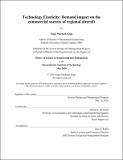Technology elasticity : demand impact on the commercial success of regional aircraft
Author(s)
Murbach Koga, Tiago.
Download1263245107-MIT.pdf (11.78Mb)
Alternative title
Demand impact on the commercial success of regional aircraft
Other Contributors
Massachusetts Institute of Technology. Engineering and Management Program.
System Design and Management Program.
Advisor
Olivier L. de Weck.
Terms of use
Metadata
Show full item recordAbstract
The law of demand is the simplest and the most important concept in microeconomics. It describes the relationship between the demand of a good and its price and the slope of the curve is defined as the price elasticity. The revenue -- the product of price and demand -- is the imperative attribute to define the company value. The valuation considers not only the actual revenue, but the year-to-year revenue growth rate. It is known that innovative companies have a high revenue growth rate, because they offer products and services that meet the consumer needs. However, microeconomics theory models lack to unify the demand, price and utility of technologically enabled goods and services. This work proposes a new approach to add the technology component in the law of demand as a function of price and utility. The utility of goods or services is described as Multi-Attribute Utility (MAU) and applied to an aviation case study. The MAU considers not only the technical aircraft performance attributes but also the social aspects of regional aircraft - twin-turboprops and jets - into the market. The data analysis shows that price and MAU have a positive correlation of 0.92 for regional jets. Similarly, the twin-turboprop airplanes have a correlation of 0.86. The price and demand are mildly positively correlated with demand. In other words, higher priced aircraft have higher demand. Conversely, lower prices correlate with lower demand. This contradicts the law of demand that states that demand varies inversely with price. These inconsistencies are explained by the concept of Technology Elasticity. In this new approach a good can have multiple levels of demand at the same price, and those levels are graded by MAU iso-utility contour lines. This approach is explained with the tea market case that the economist Alfred Marshall proposed his original theory in 1890. The actual regional jet and twin-turboprop aircraft market data is used to validate the new approach. This thesis ends with a reflection about the regional aircraft landscape and it suggests the application of technology elasticity to other markets.
Description
Thesis: S.M. in Engineering and Management, Massachusetts Institute of Technology, System Design and Management Program, May, 2020 Cataloged from the official version of thesis. Includes bibliographical references (pages [101]-106).
Date issued
2020Department
Massachusetts Institute of Technology. Engineering and Management ProgramPublisher
Massachusetts Institute of Technology
Keywords
Engineering and Management Program., System Design and Management Program.